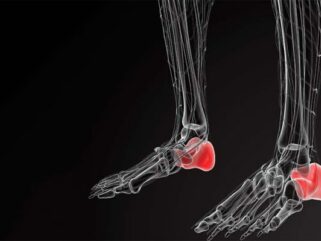The heel bone (calcaneus) is the most commonly fractured bone in the foot. Heel bone fracture is often caused by high impact to the heel — for example, when a person has fallen from a height or has been in a car accident. Injuries can range from a bone crack to a shattered bone, depending on the amount of force induced by the impact.
The most common symptoms of a calcaneus fracture are:
- Pain
- Bruising
- Swelling
- Heel deformity
- Inability to put weight on the heel when walking
It is important that your podiatrist knows the circumstances of your injury. It is just as important for your podiatrist to know if you have any other injury or medical problem, such as diabetes. After discussing your symptoms and medical history, your podiatrist will do a careful examination. He will look for other injuries and for areas where the skin is damaged or punctured. Your podiatrist will check to see if there is a good blood supply to your foot and if the nerves to your foot are working properly.
Treatments for calcaneus fracture may include:
- Rest from weight bearing, or standing and walking with crutches
- Thorough padding of the heel
- Splinting or casting to protect the heel bone
- Pain relievers
- Surgery
- Physical therapy
- Specific exercises that improve the range of motion in your foot and ankle, and strengthen the supporting muscles.
Rehabilitation
Whether you had surgery for heel bone fracture or not, your rehabilitation will be very similar. How long it takes to return to daily activities depends on the severity of the injury. Some patients can begin weight-bearing activities a few weeks after injury or surgery; some patients may need to wait 3 or more months before putting any kind of weight on the heel.
- Early motion: Many podiatrists encourage motion of the foot and ankle early in the recovery period. For example, some patients are instructed to begin moving the affected area as soon as their pain tolerance allows it. Patients who have had surgery are instructed to begin moving the affected area as soon as the wound heals, which of course depends on the podiatrist’s satisfaction.
- Weight-bearing: When you begin walking, you may need to use a cane and wear a special boot. It is very important to follow your podiatrist’s instructions when walking on your own. If you place weight on your foot too soon, the bone pieces may move out of place and you might require surgery. If you have had surgery already, the screws might loosen or break and the bone may collapse.
Heel bone fracture can be very debilitating, Podiatrists have a strong knowledge of the anatomy of the calcaneus, which is paramount to understanding the fracture patterns one may see with this injury.


